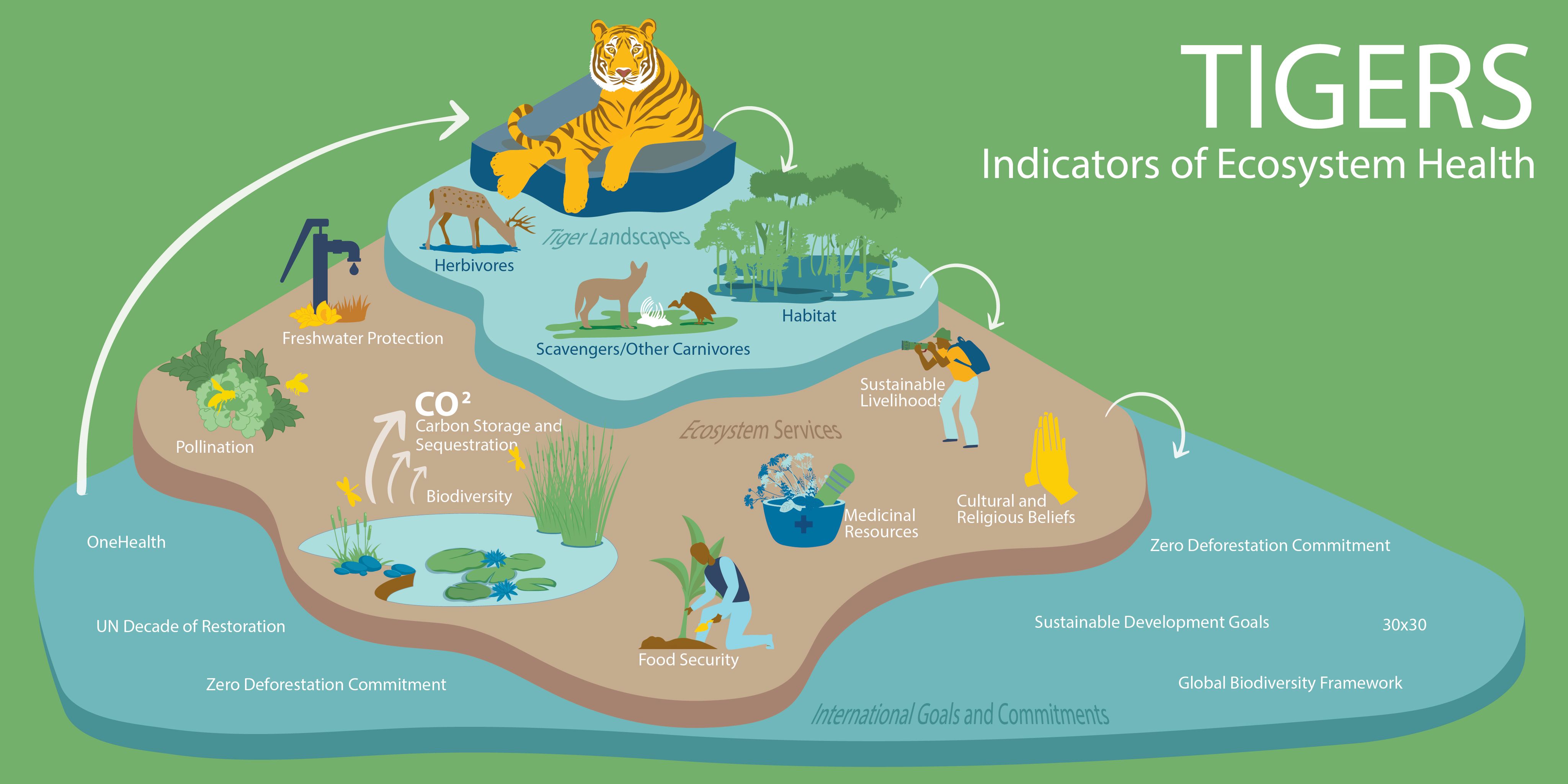Sustainable Finance for Tiger Landscapes
Securing the Stripes
April 12, 2024

Tigers are amazing animals and measurable drivers of biodiversity in their habitats. From cultural icons to valuable indicators of their ecosystems, they are as familiar as they are alluring. Sadly, with habitat destruction, poaching, and conflict with humans, the odds seem stacked against them. In response to that, leaders and their partners from countries where tigers roam, including the Tiger Conservation Coalition, have been working to help tigers. Together, we’ve been building experience, and collecting data and case studies about what it takes to stabilise and recover tiger populations.
After decades of conservation efforts, global wild tiger numbers have been increasing, but the progress is fragile, and we can’t afford to lose momentum. What’s the next urgent step for them? Pouncing on sustainable financing for the conservation of their landscapes so that we can continue our conservation progress.
What is sustainable financing and how will it help tigers?
Sustainable financing for conservation areas means investment decisions are made with environmental and social impacts in mind, and the awareness that successful conservation initiatives take time and investment. For tiger habitats, this comprises adequate, long-term investments in tiger conservation by public and private sectors that support clearly defined tiger conservation goals. It ensures tiger landscapes are climate-resilient and that there are environmental, social and economic benefits for the region.
To recover tiger numbers and restore their ecosystems, this approach involves collaboration between countries where tigers live, donors (both private and public) outside of tiger range countries, international agencies, and NGOs. Sustainable financing for tiger landscapes will develop and replicate successful conservation finance models, such as Bhutan for Life. At the same time, it must inspire large-scale investments for sustainable economic recovery in these areas. And all this must be implemented with the participation of Indigenous People and local communities.

It’s time to pounce on sustainable financing
Conservation is a long-term investment. It took decades of dedication and conservation interventions to build what is now an increasing global tiger population. To keep up the momentum, we need to set up long-term funding mechanisms that match the commitments we need, or we are at risk of losing the progress we have been able to achieve. That’s why we need to look at innovative ways to fund tiger conservation and the landscapes that support tigers.
Sustainable financing is the best way forward to deliver conservation impact at scale and align with ambitions for green economic growth for the people living in and around spaces with tigers.
Why tiger landscapes are so important
We all know that the significance of tigers extends beyond their ecological roles. Culturally, they are symbols of strength, courage, and royalty across various traditions. Their allure also has a considerable impact on tourism, especially in countries like India, where wild tiger safaris are a significant attraction. This not only helps in raising awareness about tiger conservation but also contributes to local economies, providing an incentive for governments and communities to protect these magnificent animals and their habitats.
In fact, tiger landscapes are some of the last wild spaces in Asia and are home to resources and services with an economic value in the trillions in USD per year that support over 100 million people.
For biodiversity overall, and tigers specifically, the continued focus on short-term grant-based funding will not be sufficient for the impact we need to make. It is at a different scale and magnitude, so we need to think differently, and we need to think collaboratively. We’ll need to ensure there is a reliable and uninterrupted flow of funding invested into various actions of the conservation mix, with the environment, social and governance considerations in mind. The Tiger Conservation Coalition is actively exploring and collaborating on innovative financing mechanisms for tiger conservation at the site, landscape and global scales.

United in tiger conservation
Working together is the only way to sustain current progress and see future success for tiger conservation. The Tiger Conservation Coalition is an independent group of organizations that brings together leading biologists and experts in wildlife crime, human-wildlife coexistence, policy, finance, development and communications, with unprecedented alignment on achieving tiger conservation at scale. Its member organisations include the Environmental Investigation Agency (EIA); International Union for Conservation of Nature (IUCN); Fauna & Flora International (FFI); Natural State; Panthera; TRAFFIC; United Nations Development Programme (UNDP); Wildlife Conservation Society (WCS); World Wide Fund for Nature (WWF); and the Zoological Society of London (ZSL).
An event to finance tiger lands
The Sustainable Financing for Tiger Landscapes Conference, is an event to bring together leadership and creative minds around the issue of innovative financing. The conference is hosted by the Royal Government of Bhutan and held April 22-23, 2024 under the Royal Patronage of Her Majesty the Queen Jetsun Pema Wangchuck and co-organised by the Royal Government of Bhutan and the Tiger Conservation Coalition. Implementing sustainable financing plans at landscape scale across the tiger range will help tiger range countries - and the international partners who support them - realise their commitments under the Kunming-Montreal Global Biodiversity Framework, the Sustainable Development Goals, the United Nations Framework Convention on Climate Change, and the UN Decade on Restoration, among other important global initiatives.

Even though tigers are iconic species that attract significant capital, tiger range countries have limited investment from the domestic private sector and individual donors in recovering and securing populations. Considering the increasing wealth across the globe, we want to seek investments from public and private partnerships, while also testing innovative and sustainable financial instruments, that could significantly boost financing for and engagement in tiger conservation. By investing in tiger conservation at the landscape, regional, and national scales, we can address the multitude of environmental and developmental issues that Asia is facing and ensure a sustainable future for tigers and the people who live in tiger landscapes.
Learn more about the Sustainable Finance for Tiger Landscapes Conference here: Sustainable Finance for Tiger Landscape - Tiger Finance (tiger-finance.org)

 Locations
Locations


